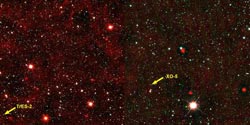Stardust discovered in far-off planetary systems

Around the stars TrES-2 in the Draco constellation and XO-5 in the Lynx constellation astronomers from Jena University found a stardust belt. photo: WISE Image Service<br>
Searching for extra-solar planets – which are planets outside of our solar system – is very popular these days. About 700 planets are known at the moment, a number that is continuously rising due to refined observational techniques. Professor Alexander Krivov and his team of astronomers of the Friedrich Schiller University Jena (Germany) just made a remarkable discovery: the scientists from the Astrophysical Institute were able to establish proof of so-called debris discs around two stars. The debris discs are remnants of the formation of the planets. “We are dealing with enormous accumulations of chunks of matter which create dust when they collide“, Alexander Krivov says. This dust is of greatest importance for the astronomers, because it helps to draw conclusions about the planet formation. There are even two debris discs in our solar system, the asteroid belt and the Kuiper belt amongst whose bodies the dwarf planet Pluto belongs.
What makes the Jena discovery so special is the tremendous distance from our solar system to the stars with the debris discs. “These stars are hundreds of light years away from the Earth“, according to Krivov. The particular focus is on TrES-2 in the Draco constellation and XO-5 in the Lynx constellation. Planets orbiting these stars can only be detected with the help of the transit method. It sounds like a simple principle: The night sky is photographed in regular intervals. Special software then checks the brightness of the stars on the images. If, in regular intervals, there are differences in brightness it is likely that a planet passes between the star and its observers.
The astronomers found evidence for the stardust with the help of photometric analysis. At first the characteristics of the stars can be analysed with it. If there are irregularities in the invisible infrared range, they point to the existence of stardust. Krivov says: “The dust is warmed up by the star and radiates heat. We see that radiation curve is above the radiation curve of the star as a clear sign of the existence of stardust.”
Professor Krivov draws an impressive comparison for the search of debris discs in the vastness of the universe: it is as if you would detect an ice-cream cooled down to minus 130 degrees with a heat detector in a 5,000 kilometer distance from Jena.
Alexander Krivov’s team of scientists concentrated its search for debris disc candidates on about 100 known extra-solar systems with transiting planets. Of these systems, they found 52 in the observational results of the US-American space telescope WISE published in April this year. The Jena scientists got lucky with two systems. As early as 1 June Alexander Krivov, Martin Reidemeister, Simone Fiedler, Dr. Torsten Löhne und Professor Ralph Neuhäuser submitted their paper to the science magazine ‘Monthly Notices of the Royal Astronomical Society’ for publication in the ‘Letters’ section. Meanwhile the paper has been published under the title ‘Debris disc candidates in systems with transiting planets’ (doi:10.1111/j.1745-3933.2011.01133.x).
Contact Details:
Prof. Dr. Alexander Krivov
Astrophysikalisches Institut und Universitätssternwarte der Friedrich-Schiller-Universität Jena
Schillergässchen 2-3, D-07745 Jena
phone: ++49 3641 947530
email: krivov[at]astro.uni-jena.de
Media Contact
More Information:
http://www.uni-jena.deAll latest news from the category: Physics and Astronomy
This area deals with the fundamental laws and building blocks of nature and how they interact, the properties and the behavior of matter, and research into space and time and their structures.
innovations-report provides in-depth reports and articles on subjects such as astrophysics, laser technologies, nuclear, quantum, particle and solid-state physics, nanotechnologies, planetary research and findings (Mars, Venus) and developments related to the Hubble Telescope.
Newest articles

A universal framework for spatial biology
SpatialData is a freely accessible tool to unify and integrate data from different omics technologies accounting for spatial information, which can provide holistic insights into health and disease. Biological processes…

How complex biological processes arise
A $20 million grant from the U.S. National Science Foundation (NSF) will support the establishment and operation of the National Synthesis Center for Emergence in the Molecular and Cellular Sciences (NCEMS) at…

Airborne single-photon lidar system achieves high-resolution 3D imaging
Compact, low-power system opens doors for photon-efficient drone and satellite-based environmental monitoring and mapping. Researchers have developed a compact and lightweight single-photon airborne lidar system that can acquire high-resolution 3D…





















